Bermuda Triangle: Expert says issue lies at 'core' of Earth
We use your sign-up to provide content in ways you’ve consented to and to improve our understanding of you. This may include adverts from us and 3rd parties based on our understanding. You can unsubscribe at any time. More info
The Bermuda Triangle is an area off the eastern coast of the US that is said to be behind the disappearance of dozens of planes and aircraft. Although measuring between 500,000 and 1,500,000 square miles, the mysterious region does not appear on official maps. Its boundaries are generally said to stretch from Florida to the Greater Antilles islands up to Bermuda. Over the last 200 years some 50 ships and 20 aircraft have vanished in the Triangle, with many of the incidents unable to be explained by physical science.
US Navy bombing mission, Flight 19, is one of the Triangle’s most notorious disappearances, which helped seal its eerie reputation.
The squadron of five planes and their 14-man crew disappeared over the Triangle shortly after the end of World War 2 and were never seen again.
Last year a new team of investigators got together to try and solve the case of Flight 19, which remains one of the Triangle’s most elusive mysteries.
The team’s efforts were chronicled for a fresh season of the documentary series, ‘History’s Greatest Mysteries’.
The History Channel US programme is presented, and executive produced by Hollywood actor and director, Laurence Fishburne.
JUST IN: La Palma volcano warning: ‘Unstoppable’ lava clocked at record speeds of 10m per second


The show catches up with chief researcher Rob Kraft, who leads the mission onboard the high-tech research vessel the RV Petrel.
The documentary explains how Mr Kraft’s team onboard the Petrel has a history for making major deep-sea discoveries.
In 2018 he and his fellow researchers found the wreckage of the aircraft carrier, the USS Lexington.
The ship was sunk in 1942 during World War 2, along with her 35 aircraft, some 500 miles off Australia’s eastern coast.
A total of 216 men of the ship’s almost 3,000-strong crew lost their lives as the ship went down after a torpedo attack by the Japanese.

The amazing discovery of the Lexington has now proved influential in the hunt for the missing Flight 19 aircraft.
The researchers found that the Lexington’s sunken F4F Wildcat aircraft were preserved in pristine condition on the ocean floor.
This is due to the reduced erosion that takes place in deep-sea environments because of the lack of oxygen.
The documentary catches up with the Petrel’s lead technician Paul Mayer, who explained the process.
DON’T MISS:
Archaeologists stunned by ‘astonishing information’ discovered in ancient Petra [LATEST]
Alzheimer’s breakthrough after study suggests one vitamin ‘could protect’ against disease [INSIGHT]
Brian Cox hinted God’s existence still on table: ‘Science doesn’t have all answers’ [ANALYSIS]

He said that the preservation of the paintwork and wreckage of the planes would help the experts put together an idea of how the Flight 19 aircraft might look if found.
Studying one image of a Wildcat he said: “Here is a 3D model of an F4F.
“This is in about 10,000 feet of water so the paint is still in very good condition.”
The expert then went into detail about some of the minute details that had been preserved on the body of the planes.

He added: “On this particular aircraft we have victory tallies here of how many Japanese planes were shot down.
“There’s a bomb here, representing that he did a bombing mission and then the insignia of that flight group.”
‘History’s Greatest Mysteries’ is available on the History Channel US.
Source: Read Full Article


